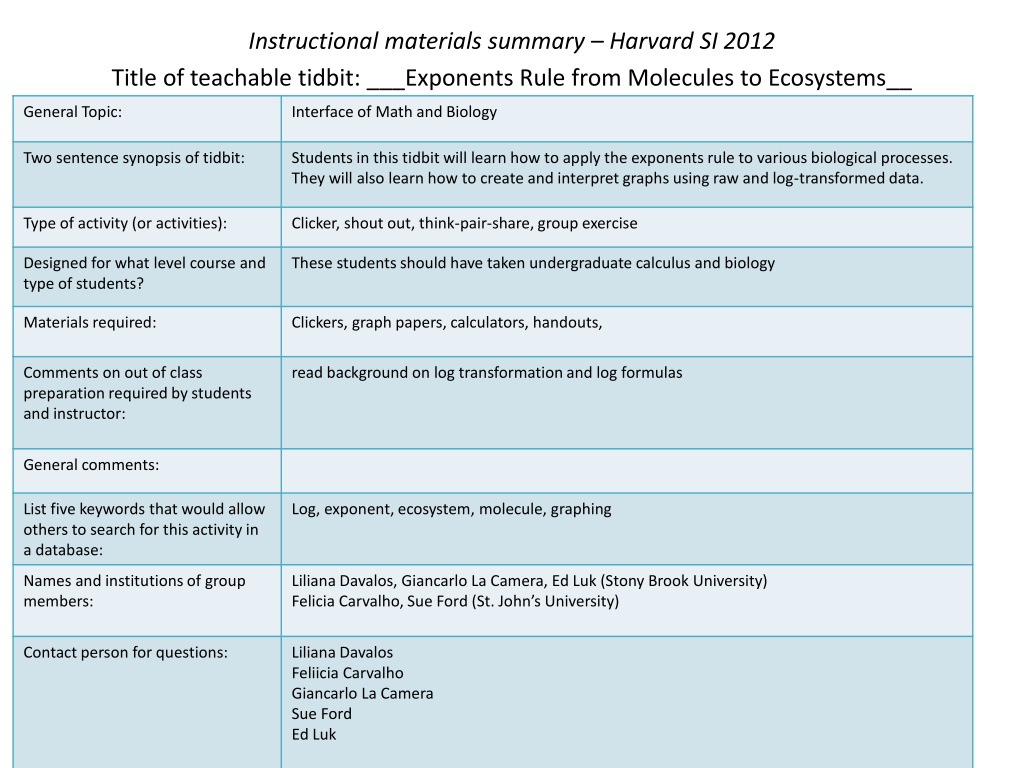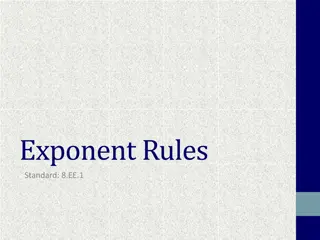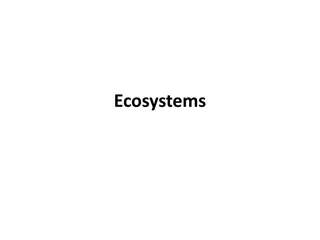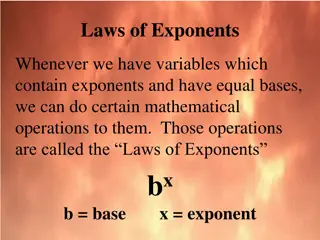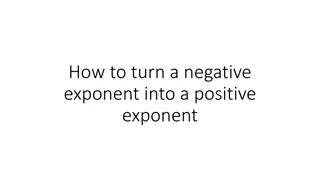Mathematics and Biology Integration: Exponents Rule in Biological Processes
Students engage in applying the exponents rule to biological phenomena, creating and interpreting graphs with raw and log-transformed data. This activity is designed for students with backgrounds in calculus and biology, fostering a deeper understanding of math-biology interface through practical applications.
Download Presentation

Please find below an Image/Link to download the presentation.
The content on the website is provided AS IS for your information and personal use only. It may not be sold, licensed, or shared on other websites without obtaining consent from the author. Download presentation by click this link. If you encounter any issues during the download, it is possible that the publisher has removed the file from their server.
E N D
Presentation Transcript
Instructional materials summary Harvard SI 2012 Title of teachable tidbit: ___Exponents Rule from Molecules to Ecosystems__ General Topic: Interface of Math and Biology Two sentence synopsis of tidbit: Students in this tidbit will learn how to apply the exponents rule to various biological processes. They will also learn how to create and interpret graphs using raw and log-transformed data. Type of activity (or activities): Clicker, shout out, think-pair-share, group exercise Designed for what level course and type of students? These students should have taken undergraduate calculus and biology Materials required: Clickers, graph papers, calculators, handouts, Comments on out of class preparation required by students and instructor: read background on log transformation and log formulas General comments: List five keywords that would allow others to search for this activity in a database: Log, exponent, ecosystem, molecule, graphing Names and institutions of group members: Liliana Davalos, Giancarlo La Camera, Ed Luk (Stony Brook University) Felicia Carvalho, Sue Ford (St. John s University) Contact person for questions: Liliana Davalos Feliicia Carvalho Giancarlo La Camera Sue Ford Ed Luk
Exponents Rule from Molecules to Ecosystems Group 2: Interface of Biology and Math Ed Luk, Giancarlo La Camera, Liliana D valos Stony Brook University Felicia Carvalho, Sue Ford St. John s University Facilitators: Xinnian Chen, Martin Samuels
Exponents Rule from Molecules to Ecosystems Context and Audience: 2-week unit in a course for sophomore or juniors majoring in Biology, ~40 students Background: 2 semesters of college math, introductory biology 1 and 2. Preceding units of the course cover linear, inverse relationships, and power relationships Assumed knowledge: Students know mathematical formulas but cannot apply to real-world problems (Bloom s levels 1 and 2) Basic arithmetic Have knowledge logarithms and antilogs Know equations for straight line
Objectives / learning outcomes Students will be able to: 1. Justify the decision to log-transform data; 2. Create and interpret graphs using raw and log-transformed data.
How many butterfly species? 5000 square miles 100 butterfly species 2500 square miles How many butterfly species? The Florida Bugaboo Fire - Lake City, Fla., May 15, 2007 by Mark Wolfe/FEMA http://www.photolibrary.fema.gov/photodata/original/29930.jpg Train route Goa forest by Mohan P. http://www.publicdomainpictures.net/pictures/10000/velka/417-221153452NXrX.jpg
Think-pair-share Question: 5000-square mile forest has 100 butterfly species; how many species in 2500- square mile remnant? Think for a moment about how many species there will be Talk with your neighbor for one minute about what you think Share with the class
Area (miles2) # Butterfly species 222 314 371 528 877 8171 40942 70205 157600 668536 35 39 40 42 49 1 22 207 248 323 549
# Area (miles2) Butterfly species 35 500 222 400 314 39 # Butterfly Species 371 40 10 10 300 528 42 877 49 200 8171 1 22 100 40942 207 70205 248 200,000 400,000 600,000 2,500 157600 323 Area in miles2 668536 549
How many species in 2500 miles2? A. About 25 B. About 50 C. About 75 D. About 90 E. I cannot tell how many species there will be
This is the log-transform 500 400 300 400 # Butterfly Species # Butterfly Species 200 10 10 300 10 10 100 90 200 75 50 90 75 50 25 100,000 10,000 50,000 200,000 400,000 600,000 1,000 2,500 5,000 Area in miles2 500 2,500 Area in miles2
How did that work? Logarithmic transformation used to rescale the x or y values, or both This transformation has converted the data to a linear equation y = mx +b 400 300 # Butterfly Species 200 150 10 10 100 75 50 100,000 10,000 50,000 1,000 2,500 5,000 Area in miles2 500
Handouts Groups 1&3 take dataset 1 Groups 2&4 take dataset 2 Groups 5&6 take dataset 3 For your dataset: Which data would you transform, X or Y? Why did you choose that axis? Plot 4 data points using your log transformed data on the graph paper provided to you.
100000000 time after inoculation 10 20 30 40 50 cell # 11000 97600 993000 10000000 85000000 Log ??? 80000000 60000000 Cell # 40000000 20000000 0 0 10 20 30 40 50 60 Time after inoculation (days)
Cell proliferation time after inoculation 10 20 30 40 50 cell # 11000 97600 993000 10000000 85000000 Log cell # 4.0414 4.9894 5.9969 7 7.9294 10 8 Log Cell # 6 4 2 0 0 10 20 30 40 50 60 Time after inoculation (days)
